Finally got some time to work on this question today. Putting this on an NSOutlineView is the easy part. The hard part is to define a data model for your TLV data and parse the Data into it.
TLVNode.swift
This class stores the TLV data. Your code looks like converted C and then it's not very good C either.
import Foundation
// Since we use Cocoa Bindings, all properties need to be
// dynamically dispatch hence @objCMembers declaration
// Its ability to handle erroneous data is not tested. That
// is left for the OP as an exercise.
@objcMembers class TLVNode: NSObject {
var tag: Data
var length: Int
var value: Data
var isConstructed: Bool
var children = [TLVNode]()
// Convert `tag` from Data to a string of hex for display
var displayTag: String {
// Pad the hex value with 0 so it outputs `0d` instead of just `d`
return tag.map { ("0" + String($0, radix: 16)).suffix(2) }.joined()
}
// Convert `value` from Data to string of hex
var displayValue: String {
let hexValues = value.map { ("0" + String($0, radix: 16)).suffix(2) }
var str = ""
for (index, hex) in hexValues.enumerated() {
if index > 0 && index % 4 == 0 {
str += " " + hex
} else {
str += hex
}
}
return str
}
convenience init?(dataStream: Data) {
var size = 0
self.init(dataStream: dataStream, offset: 0, size: &size)
}
static func create(from dataStream: Data) -> [TLVNode] {
var size = 0
var offset = 0
var nodes = [TLVNode]()
while let node = TLVNode(dataStream: dataStream, offset: offset, size: &size) {
nodes.append(node)
offset += size
}
return nodes
}
/// Intialize a TLVNode object from a data stream
///
/// - Parameters:
/// - dataStream: The serialized data stream, in TLV encoding
/// - offset: The location from which parsing of the data stream starts
/// - size: Upon return, the number of bytes that the node occupies
private init?(dataStream: Data, offset: Int, size: inout Int) {
// A node must have at least 3 bytes
guard offset < dataStream.count - 3 else { return nil }
// The number of bytes that `tag` occupies
let m = dataStream[offset] & 0x1F == 0x1F ?
2 + dataStream[(offset + 1)...].prefix(10).prefix(while: { $0 & 0x80 == 0x80 }).count : 1
// The number of bytes that `length` occupies
let n = dataStream[offset + m] & 0x80 == 0x80 ? Int(dataStream[offset + m] & 0x7f) : 1
guard n <= 3 else { return nil }
self.tag = Data(dataStream[offset ..< (offset + m)])
self.length = dataStream[(offset + m) ..< (offset + m + n)].map { Int($0) }.reduce(0) { result, element in result * 0x100 + element }
self.value = Data(dataStream[(offset + m + n) ..< (offset + m + n + length)])
self.isConstructed = dataStream[offset] & 0x20 == 0x20
size = m + n + length
if self.isConstructed {
var childOffset = 0
var childNodeSize = 0
while let childNode = TLVNode(dataStream: self.value, offset: childOffset, size: &childNodeSize) {
self.children.append(childNode)
childOffset += childNodeSize
}
}
}
private func generateDescription(indentation: Int) -> String {
return "\(String(repeating: " ", count: indentation))\(tag as NSData) \(length) \(value as NSData)\n"
+ children.map { $0.generateDescription(indentation: indentation + 4) }.joined()
}
// Use this property when you need to quickly dump something to the debug console
override var description: String {
return self.generateDescription(indentation: 0)
}
// A more detailed view on the properties of the current instance
// Does not include child nodes.
override var debugDescription: String {
return """
TAG = \(tag as NSData)
LENGTH = \(length)
VALUE = \(value as NSData)
CONSTRUCTED = \(isConstructed)
"""
}
}
View Controller
import Cocoa
class ViewController: NSViewController {
@objc var tlvNodes: [TLVNode]!
override func viewDidLoad() {
super.viewDidLoad()
let data = Data(bytes:
[ 0xe1,0x35,
0x9f,0x1e,0x08,0x31,0x36,0x30,0x32,0x31,0x34,0x33,0x37,
0xef,0x12,
0xdf,0x0d,0x08,0x4d,0x30,0x30,0x30,0x2d,0x4d,0x50,0x49,
0xdf,0x7f,0x04,0x31,0x2d,0x32,0x32,
0xef,0x14,
0xdf,0x0d,0x0b,0x4d,0x30,0x30,0x30,0x2d,0x54,0x45,0x53,0x54,0x4f,0x53,
0xdf,0x7f,0x03,0x36,0x2d,0x35,
// A repeat of the data above
0xe1,0x35,
0x9f,0x1e,0x08,0x31,0x36,0x30,0x32,0x31,0x34,0x33,0x37,
0xef,0x12,
0xdf,0x0d,0x08,0x4d,0x30,0x30,0x30,0x2d,0x4d,0x50,0x49,
0xdf,0x7f,0x04,0x31,0x2d,0x32,0x32,
0xef,0x14,
0xdf,0x0d,0x0b,0x4d,0x30,0x30,0x30,0x2d,0x54,0x45,0x53,0x54,0x4f,0x53,
0xdf,0x7f,0x03,0x36,0x2d,0x35
])
// The Tree Controller won't know when we assign `tlvNode` to
// an entirely new object. So we need to give it a notification
let nodes = TLVNode.create(from: data)
self.willChangeValue(forKey: "tlvNodes")
self.tlvNodes = nodes
self.didChangeValue(forKey: "tlvNodes")
}
}
Interface Builder Setup
We will use Cocoa Bindings since populating an Outline View manually can be quite tedious (see my other answer) and your example screenshot look like you are already heading in that direction. A word of caution: while Cocoa Binding is very convenient, it should be considered an advanced topic since it's rather hard to troubleshoot. On your storyboard:
- From the Object library on the right, add a Tree Controller to your scene
- Select the Tree Controller, in the Attributes inspector, set Children = children
- Drag out an Outline View and configure it with 3 columns. We will name them Tag, Length and Value

Open the Bindings Inspector, for the 5 highlight objects, set their bindings as follow:
| IB Object | Property | Bind To | Controller Key | Model Key Path |
|-----------------|-------------------|-----------------|-----------------|--------------------------|
| Tree Controller | Controller Array | View Controller | | self.tlvNodes |
| Outline View | Content | Tree Controller | arrangedObjects | |
| Table View Cell | Value | Table Cell View | | objectValue.displayTag |
| (Tag column) | | | | |
| Table View Cell | Value | Table Cell View | | objectValue.length |
| (Length column) | | | | |
| Table View Cell | Value | Table Cell View | | objectValue.displayValue |
| (Value column) | | | | |

Result:



